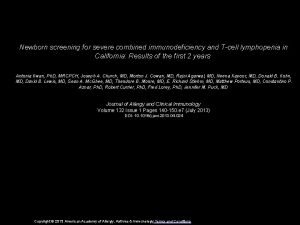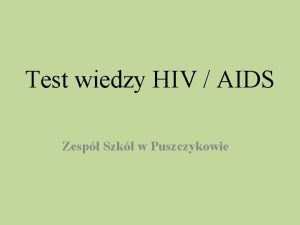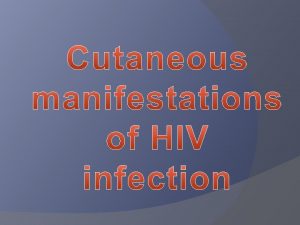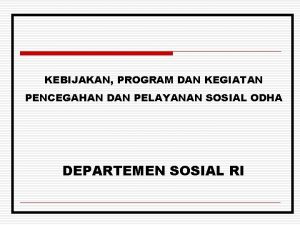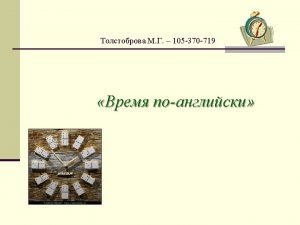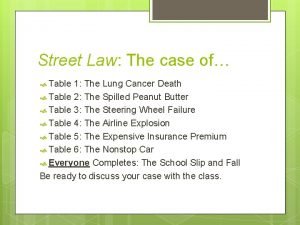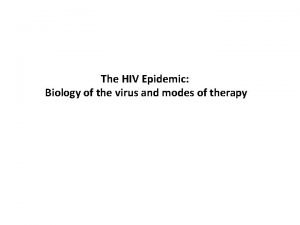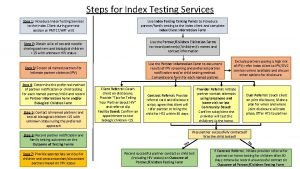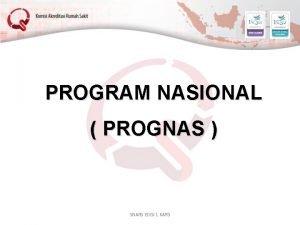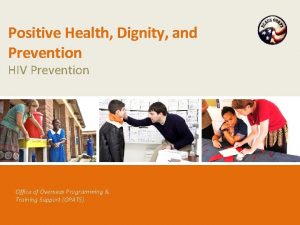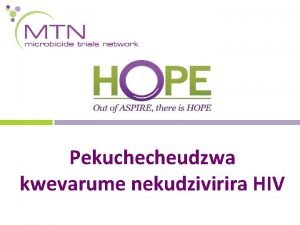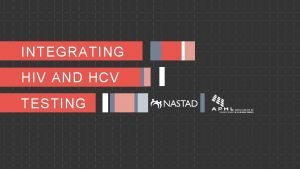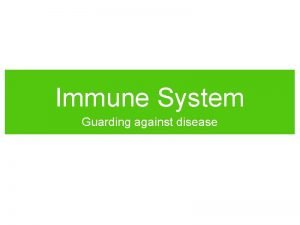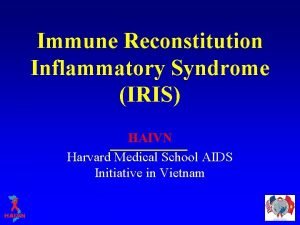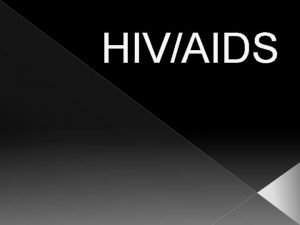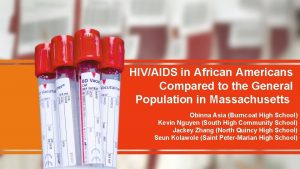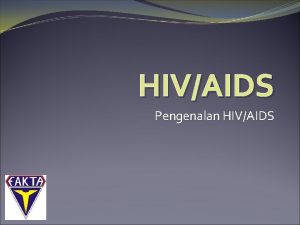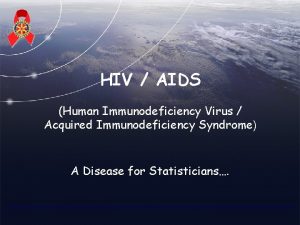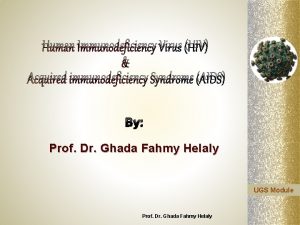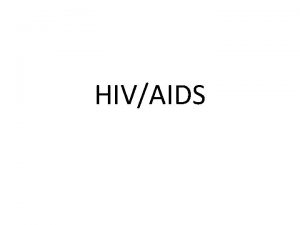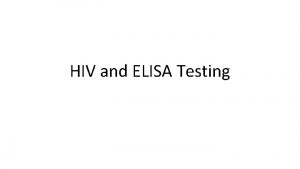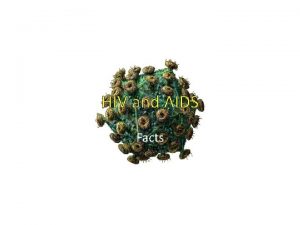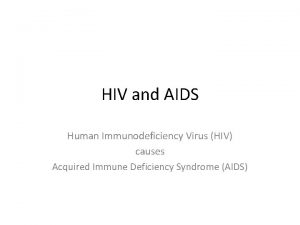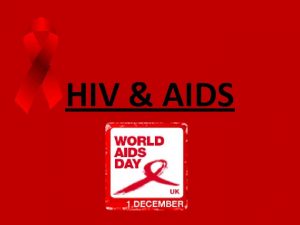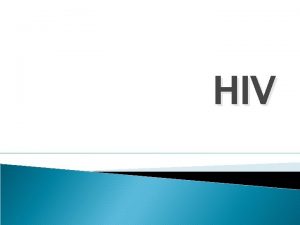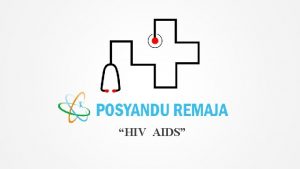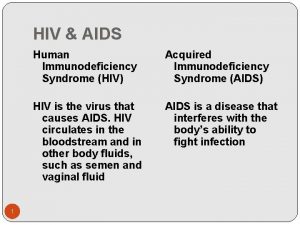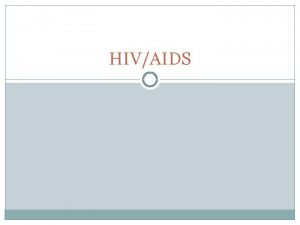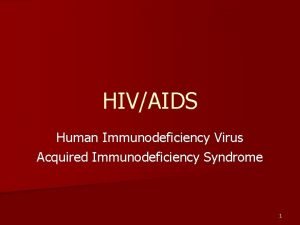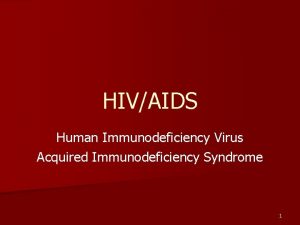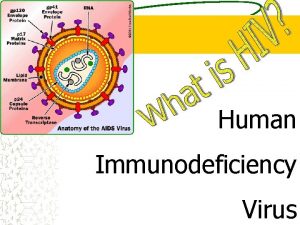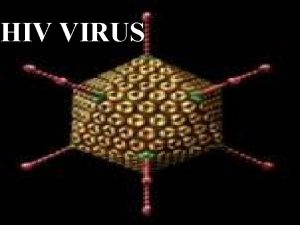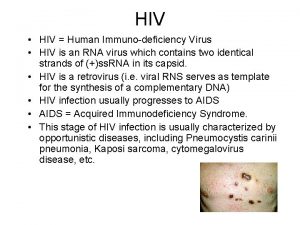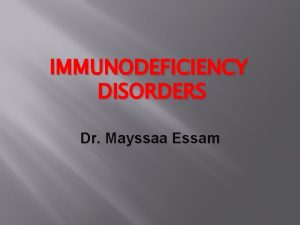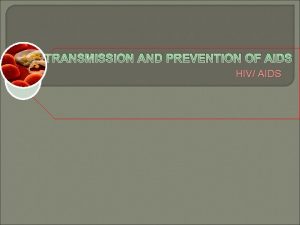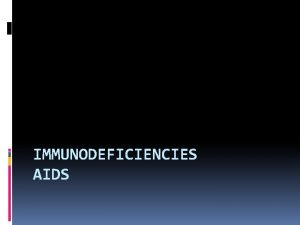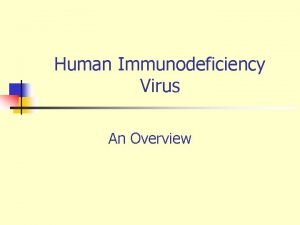Chapter Sixteen HIV and AIDS HIVAIDS Human Immunodeficiency

























- Slides: 25

Chapter Sixteen HIV and AIDS

HIV/AIDS • Human Immunodeficiency Virus (HIV) – Immune system deficient, cannot resist disease – Virus responsible for Acquired Immune Deficiency Syndrome (AIDS) • Acquired Immune Deficiency Syndrome (AIDS) – Descriptive of the infection and it’s progression – First observed in U. S. cities in early 1980 s – Young, healthy men dying of rare diseases

Conditions Associated with AIDS • Opportunistic infections – Pneumocystis carinii pneumonia (PCP) – Mycobacterium avium intracellulare • Clinical conditions – Wasting syndrome • Cancers – Kaposi’s sarcoma • Other infections – Candidiasis – Herpes and cytomegalovirus

Symptoms of HIV Infection and AIDS • • • Unexplained persistent fatigue Fever, chills, night sweats Unexplained weight loss Swollen lymph nodes Pink, red, purple, or brown blotches Persistent dry cough • • • Persistent, fuzzy, white spots in mouth, tongue, or throat Memory loss or depression Abnormal pap smears Persistent vaginal candidiasis Abdominal cramping (due to Pelvic inflammatory Disease) Persistent Diarrhea

The Immune System and HIV • • Leukocytes – white blood cells Macrophages • Engulf foreign particles – Antigens • Stimulate immune system, react with antibodies – Antibodies • Inactivate antigens, mark them for destruction • B cells and T cells – Lymphocytes – Helper T cells

The Virus • • • Protein coated package of genes Spherical GP 120 Reverse transcriptase Retrovirus Effect on T cells

How the Disease Progresses • • • T cell (CD 4) count Viral load counts Phases of infection – Months to years – Early flu-like symptoms AIDS Death

Epidemiology and Transmission of HIV • • • Epidemiology – Study of incidence, process, distribution, and control of a disease World Health Organization reports 25 million people have died from AIDS Estimated that 40. 3 million people are living with HIV

Epidemiology and Transmission of HIV • • Global increases in number of people living with AIDS African continent the largest concentration 2/3 of all AIDS cases are in Sub-Saharan Africa 77% of women living with AIDS are in Sub -Saharan Africa

Epidemiology and Transmission of HIV in the United States • • 944, 306 individuals living with AIDS 40, 000 annual new HIV infections Changes in current transmission modes Changes across ethnic groups

Modes of Transmission • • Sexual contact Sharing needles Transfusions Passing virus from mother to fetus

Modes of Transmission • • Breastfeeding from HIV-positive mother Sharing sex toys Accidental contamination with infected blood Contaminated blood transfusions or organ transplants performed before April 1, 1985

Myths about Transmission • • • Non sexual contact – touching a person Touching a surface – toilet seat Social contact – kissing, biting or tears Insect bites Accidental contact in sports Donating blood

Sexual Transmission • • Anal intercourse Vaginal intercourse Oral sex Sex toys

Injection Drug and Substance Use • • • Sharing needles Sharing other paraphernalia Recreational use resulting in poor decision making

Mother to Child Transmission • • Peri natal transmission Greatly reduced by use of ZDV (AZT) – Mother takes ZDV from week 14 to 34 – Infant takes ZDV

Minority Races and Ethnicities and HIV • • • In the early 80 s, was viewed as a disease in Whites and gays Currently identified in all ethnic groups Occurs in groups with – Poverty – Lack of access to or willingness to use health care – Substance abuse

Minority Races and Ethnicities and HIV • • African Americans Hispanics Asian/Pacific Islanders American Indians and Alaska Natives

The Gay Community • • Men who have sex with men Stigma slowed prevention efforts Special consideration of ethnic groups Psychological long term effects Increased risk taking Other STIs U. S. AIDS Demographics by Race

Other Groups and HIV • • Children Teens and college students Older adults Geographic region

Prevention and Treatment • Protecting ourselves – Be aware that alcohol and drug use increases risky behaviors – Develop communication skills to be able to discuss risks and prevention with partners – Use HIV testing and make appropriate decisions – Use condoms

Prevention and Treatment • Saving lives through prevention – Reduced new infections from 150, 000/year to 40, 000/year • Obstacles to education: blame and denial – AIDS seen as disease of marginalized group, not “us” • • Needle exchange programs HIV testing

HIV Testing • • Tests should be taken 12 weeks after highrisk behavior, repeated 6 months after an uncertain result Types of tests – ELISA - enzyme-linked immunosorbent assay – Western blot –rechecks ELISA results – Viral load tests measure HIV in bloodstream • • Getting tested Partner notification

Treatment • • Usually initiated with the diagnosis of AIDS Antiretroviral medications – – • Nonnucleoside reverse transcriptase inhibitors Nucleoside reverse transcriptase inhibitors Protease inhibitors Fusion Inhibitor HAART – Highly Active Antiretroviral Therapy – Combination of three or more medications – Reduces HIV in blood to undetectable levels

Living with HIV or AIDS • • If you are HIV positive Taking care of your health Addressing your other needs If you are caring for someone with HIV or AIDS
 Chapter 25 sexually transmitted infections and hiv/aids
Chapter 25 sexually transmitted infections and hiv/aids Chapter 24 sexually transmitted diseases and hiv/aids
Chapter 24 sexually transmitted diseases and hiv/aids Name the five lesions associated with hiv/aids chapter 17
Name the five lesions associated with hiv/aids chapter 17 What are deficiency
What are deficiency Combined immunodeficiency
Combined immunodeficiency Test wiedzy o aids z odpowiedziami
Test wiedzy o aids z odpowiedziami Causative organism of hiv/aids
Causative organism of hiv/aids Kasus hiv aids
Kasus hiv aids 16 figure compass
16 figure compass Twenty to twelve time
Twenty to twelve time 16 career clusters
16 career clusters Sixteen year old carrie is babysitting
Sixteen year old carrie is babysitting Explain how securities firms differ from investment banks
Explain how securities firms differ from investment banks 8.3 human needs
8.3 human needs Chapter 8 human needs and human development
Chapter 8 human needs and human development Quang trung
Quang trung Hiv reverse transcription
Hiv reverse transcription Hiv index testing steps
Hiv index testing steps Prognas akreditasi
Prognas akreditasi Phdp in hiv
Phdp in hiv Chii chinonzi hiv
Chii chinonzi hiv Window period hiv
Window period hiv Why do the bodys antibodies fail to protect people from hiv
Why do the bodys antibodies fail to protect people from hiv Iris hiv
Iris hiv Where did hiv come from
Where did hiv come from Hiv risk factors
Hiv risk factors




